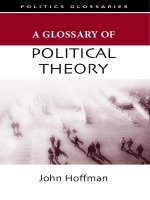edinburgh university press the ethics of peacebuilding mar 2009
Bạn đang xem bản rút gọn của tài liệu. Xem và tải ngay bản đầy đủ của tài liệu tại đây (687.06 KB, 201 trang )
THE
ETHICS OF
PEACEBUILDING
‘I can’t imagine a more important topic for our times than that of learning how to
facilitate sustainable peace through healing reconciliation based upon a foundation of
ethically informed restorative as well as social/ economic justice.’
Professor William Aiken, Chatham College, Pittsburgh
This book explores the ethical dimension of peacebuilding. In the aftermath of the
Cold War the hope for a more stable and just international order was rapidly
dissolved by the internecine conflicts that plagued all continents. The Rwanda and
Srebrenica genocides demonstrated the challenge of promoting peace in a world
increasingly defined by intra-state conflict and sub-national groups confronting
nation-states.
Tim Murithi interrogates the role that ethics plays in promoting and consolidating
peacebuilding and presents a synthesis of moral philosophy and international
relations and an analysis of the ethics of negotiation, mediation, forgiveness and
reconciliation. Exploring the extent to which ethical concerns influence and inform
peacebuilding, he contributes to a growing body of literature on ethics and
international relations which will enable students, scholars and practitioners to
ground their understanding of a principled peacebuilding.
KEY FEATURES
• Author has first-hand knowledge of peacebuilding through his work with the UN
and NGOs
• Analyses the ethics of peacebuilding inherent in the actions of the inter-
governmental and non-governmental organisations
• Examines the ethics of negotiation, mediation, forgiveness and reconciliation
• Draws on a wide range of historical and contemporary case studies including the
League of Nations, the United Nations, the Quakers in the Biafran War and the
South African and Sierra Leonean Truth Commissions
TIM MURITHI is a Senior Research Fellow with the Centre for International
Cooperation and Security (CICS) at the University of Bradford. He is the author of
The African Union: Pan-Africanism, Peacebuilding and Development (2005),
Towards a Union Government for Africa: Challenges and Opportunities (2008) and
co-editor of The African Union and its Institutions (2008).
EDINBURGH STUDIES IN WORLD ETHICS
Series Editor: Nigel Dower
Edinburgh Studies in World Ethics
Tim Murithi
THE ETHICS OF PEACEBUILDING Tim MurithiEdinburgh
Edinburgh
Cover design concept: Fionna Robson
Edinburgh University Press
22 George Square, Edinburgh EH8 9LF
www.eup.ed.ac.uk
ISBN 978 0 7486 2448 5
THE ETHICS OF PEACEBUILDING
Timothy Murithi
8127 Muritihi:8127 Muritihi 18/4/08 12:58 Page 1
THE ETHICS OF PEACEBUILDING
EDINBURGH STUDIES IN WORLD ETHICS
Other titles in the series:
The Ethics of Peace and War
Iain Atack
The Ethics of the Global Environment
Robin Attfield
Ethics, Economics and International Relations
Second Edition
Peter G. Brown
World Ethics: The New Agenda
Second Edition
Nigel Dower
The Ethics of Development
Des Gasper
THE ETHICS OF
PEACEBUILDING
Tim Murithi
EDINBURGH UNIVERSITY PRESS
For Bonnie
Tim Murithi, 2009
Edinburgh University Press Ltd
22 George Square, Edinburgh
www.euppublishing.com
Typeset in Times by
Iolaire Typesetting, Newtonmore, and
printed and bound in Great Britain by
CPI Antony Rowe Ltd, Chippenham, Wilts
A CIP record for this book is available
from the British Library
ISBN 978 0 7486 2447 8 (hardback)
ISBN 978 0 7486 2448 5 (paperback)
The right of Tim Murithi
to be identified as author of this work
has been asserted in accordance with
the Copyright, Designs and Patents Act 1988.
CONTENTS
Acknowledgements vii
Preface ix
1 Introduction 1
2 Moral Knowledge and Peacebuilding 13
3 The Morality of Conflict Resolution: A Critique of the
State System and its Management of Sub-national Conflict 42
4 The Utility of Negotiation and Mediation 71
5 The Virtue of Forgiveness 113
6 The Value of Reconciliation 136
7 Towards an Agenda for Ethical Peacebuilding 160
8 Conclusion 181
Index 187
ACKNOWLEDGEMENTS
I would like to acknowledge and thank colleagues, students and policy-
makers who have debated the virtues of peacebuilding with me over the
years. There have been many who have challenged my optimism in
human nature to achieve a more peaceful future. They have also in their
own way contributed to this book. Specifically, I would like to thank
Nigel Dower, the editor of this series, for seeing the value of this book as
a contribution to the debates on ethics and international relations and
supporting its development at every stage. I would also like to thank
Nicola Ramsey for her patience and enthusiasm during the completion
of this book.
I would like to thank John MacMillan and Andrew Linklater, who
inspired some of the research that led to the production of this book. I
would also like to thank my parents and siblings Jeremiah, Esther, Sara
and Victor, as well as my in-laws Joel, Anna, Herschel and Natacha for
their continuing love and support.
Above all I would like to thank my loving wife Bonnie Berkowitz,
who sacrificed many weekend outings so that I could complete the book
and who also read some of the chapters. She is my dearest friend,
companion and a true embodiment of the ethical person.
PREFACE
The first decade of the twenty-first century has proven to be as violent as
previous periods of human history. Conflict and political violence have
afflicted all continents and fragmented or undermined the integrity of
several nation-states, including Somalia, Afghanistan, the Democratic
Republic of the Congo, the Sudan, Colombia and the former Yugosla-
via, to name but a few. Tremendous harm has been done to ordinary
people and innocent communities. Somehow these innocent people will
have to find a way to move beyond the atrocities that they have endured
and rebuild their lives. This book will argue that in the years and decades
to come there will be a need for effective, sustainable and ethical
peacebuilding in order to heal and restore the conditions for coexistence
in these fractured communities.
The process required to heal the hearts, minds and psyches of those
harmed is challenging. This book proposes that the process of peace-
building requires an open engagement with the values and virtues of
victims, perpetrators and peacemakers. In other words, understanding
the ethics of peacebuilding is necessary for the establishment and
implementation of an effective process for building durable peace.
One might ask why peacebuilding is necessary. Is peacebuilding even
possible? This book will critically review the definition of peacebuilding
and describe it as a process that seeks to moves beyond the notion of
negative peace – which is understood as the absence of violence. It will
advance an understanding of peacebuilding as the quest for positive
peace which is the presence of healing and reconciliation based on social
and economic justice and equality. It will analyse the ethics of peace-
building inherent in the actions and dispositions of peacemakers and
peacemaking institutions like the League of Nations, the United Na-
tions, the African Union, non-governmental organisations, ecumenical
groups and civil society associations. These organisations have estab-
lished mechanisms for promoting ethical political negotiation and for
x the ethics of peacebuilding
mediating in ongoing disputes around the world. This book will further
examine the ethics of negotiation and mediation. These processes are
increasingly being relied upon to assist parties to move beyond disputes
and enter a moral space where they can begin to coexist, rebuilding and
healing their lives. Specific case studies will focus on the efforts of the
League of Nations, the United Nations and the Quakers.
The process of coming to terms with the harm that has been done is
equally difficult and painful for victims and perpetrators alike. For
forgiveness and reconciliation to succeed these actors need to draw upon
their own value-systems. The perpetrator has to acknowledge the harm
that he or she has done, make reparations where possible and ask for
forgiveness from the victim. The victim should, but is not compelled to,
grant mercy and accept the compensation or reparations made, and only
then can the process of genuine forgiveness begin and lead to healing
and reconciliation.
These processes are difficult for both the victim and the perpetrator
because the first impulse for most victims is to seek revenge through
some form of punishment for the perpetrator. In some cases this may
be necessary and perhaps the only option. The first impulse of the
perpetrator is to deny having done any harm, to deflect blame from
him- or herself and re-assign it to an external authority or institution.
Simply put, it is difficult to counter the impulse to seek revenge. The
idea of vengeance might be prevalent because most people actually
believe it is a right, even a duty, to seek revenge even at the cost of
peace. Therefore we cannot assume that there is an intrinsic value to
achieving peace at all costs. However, this book will argue that when
attempting to restore the conditions for coexistence following a brutal
ethnic conflict, the act of punishing perpetrators only promotes a
vicious cycle of mistrust, suspicion and resentment. At a later point
in time these sentiments generally resurface and manifest at a later
point in time as social, economic or political exclusion. The moral
exclusion experienced by this process can lead to resentment and can
function as a catalyst to reignite violence. In this context, the book will
argue that engaging in restorative justice rather than retributive justice
is a necessary although insufficient factor for genuinely healing a
nation and bringing about moral inclusion. This can only be done
if both perpetrators and victims are prepared to engage in a process of
ethical peacebuilding by drawing upon moral principles which this
book will discuss. In particular, this book will explore the moral
argument for engaging in forgiveness and reconciliation and will
discuss the case studies of the Truth and Reconciliation Commissions
in South Africa and Sierra Leone. Ultimately, the book will assess the
preface xi
issue of whether institutions such as the UN Peacebuilding Commis-
sion can indeed promote an ethical peace.
This is a timely book because understanding the ethics of peace-
building will provide peacemakers, victims, perpetrators and peace-
building institutions with an analysis of the moral disposition and
ethical tools necessary to achieve sustainable peace in a world that
has been afflicted by the scourge of violent conflict.
CHAPTER 1
INTRODUCTION
This book will assess the ethical dimension of peacebuilding. The
twentieth century witnessed some of the worst war atrocities committed
in the history of humanity. This included the genocide in Armenia, the
Holocaust and the wanton carnage of the Second World War. The Cold
War retained this pattern of destruction with proxy wars being fought
along the East/West or Soviet/US ideological divide. In the aftermath of
the Cold War the hope for a more stable and just international order
was rapidly dissolved by the internecine conflicts that plagued all
continents. These conflicts took on a pernicious form in the sense that
they undermined the very fabric of the nation-state. The implosion of
Somalia and Yugoslavia remain the most salient examples of this
phenomenon. In February 2008, Kosovo, a former province of Yugo-
slavia, declared its independence, to the resentment of Serbia, which
considered Kosovo a key component of its national body politic. The
Kosovar independence declaration did not happen overnight, rather it
was the culmination of a lengthy and drawn-out confrontation between
the sub-national groups in Kosovo and the Serbian nation-state. There-
fore, what we can discern is that a key feature of the majority of conflicts
that we witness today is their sub-national nature. The term sub-
national describes the subsidiary political, social and cultural polities
that exist and function within the nation-state. Sub-national conflicts
have proved to be highly resistant to the intervention of inter-govern-
mental organisations like the United Nations (UN) and regional orga-
nisations. In effect the international system has endeavoured to resolve
such conflicts with limited success. The world continues to be plagued
by sub-national conflicts in places such as the Darfur region of the
Sudan, the Kashmir region of India and Pakistan, Lebanon, Nepal, Sri
Lanka, Tajikistan, Uganda and Western Sahara. Efforts to build peace
have come under increasing scrutiny. It has also become important to
question whether the appropriate moral norms are in place in order to
2 the ethics of peacebuilding
facilitate effective peacebuilding. In particular, it is useful to explore the
qualitative challenges posed by sub-national conflicts in order to under-
stand how ethical processes, procedures, institutions and mechanisms
can be established to enhance peacebuilding. This book proposes to
assess the ethical dimensions of negotiation, mediation, forgiveness and
reconciliation in order to provide insights into some of the components
of peacebuilding.
There has been a substantial body of literature that has been devel-
oped to explore the morality of war. There has also been a significant
amount of literature on the ethics of peace, including two books in this
series, namely Nigel Dower’s World Ethics: The New Agenda and Iain
Atack’s The Ethics of Peace and War.
1
However, additional research is
required on the ethics of peacebuilding and conflict resolution. As Bruce
Barry and Robert Robinson note, there is ‘a relative dearth of scholarly
attention to the wider field of ethics in conflict resolution’.
2
Further-
more, they argue that it is important to ‘identify the ethical dimensions
of relationships among disputing parties and interveners as a common
thematic element that may represent a fruitful avenue for thinking about
the distinctive role of ethics in the resolution of conflict’.
3
This book
seeks to contribute towards a response to these suggestions by ques-
tioning the role that ethics plays in promoting and consolidating peace-
building.
It is worthwhile to note that there is a wide field of ethics and
international relations. Specifically, these traditions can be found in
cosmopolitanism and in global ethics. In particular, Dower has under-
taken an extensive study into what he calls ethical cosmopolitanism, and
notes that ‘it provides both an ethical basis for the assessment of what
individuals ought to be . . . and it provides a basis for the critical
assessment of what states and other collectives do’.
4
Dower further
develops an understanding of global ethics which emerges from the
obligation for individuals to behave in a particular way, and proposes
international ethics as pertaining to the way that states and other
collectives act. Atack also reviews political realism and international
idealism and contrasts their attitudes towards the role of ethics in
international relations and the implications that this has for the use
of force.
5
He also discusses ‘what cosmopolitanism, as a theory about
the role or place of ethics in international politics, has to say about the
specific problems of war and armed conflict’.
6
There is a range of traditions in international relations that this book
could engage with to advance its discussion of the ethics of peace-
building. However, it will engage exclusively with a critique of the realist
and statist assumptions in international relations because this serves as
introduction 3
an important platform from which to understand the contemporary
challenges of peacebuilding.
The purpose of this book, therefore, is to contribute towards the
growth of knowledge on the ethics of peacebuilding. This will indirectly
contribute towards developing an understanding of the ethics of inter-
national relations. However, prior to engaging further in a discussion of
the ethical dimension of peacebuilding, we first need to establish a
working definition of peacebuilding.
DEFINING PEACEBUILDING: CONTESTING THE
CONCEPT
In 1992, the Agenda for Peace, published by the then United Nations
Secretary-General Boutros Boutros-Ghali, defined peacebuilding as the
medium- to long-term process of rebuilding war-affected communities.
It defined peacebuilding as ‘action to identify and support structures
which will tend to strengthen and solidify peace to avoid a relapse to
conflict’.
7
Over time the definition of peacebuilding has ‘gradually
expanded to refer to integrated approaches to address violent conflict
at different phases of the conflict cycle’.
8
Peacebuilding therefore in-
cludes the process of rebuilding the political, security, social and
economic dimensions of a society emerging from conflict. At a funda-
mental level peacebuilding involves addressing the root causes of the
conflict and enabling warring parties to continue to find solutions
through negotiation and when necessary through mediation. Peace-
building includes overseeing the process of demobilisation, disarma-
ment and reintegration (DDR) as well as security-sector reform.
Building peace requires the promotion of social and economic justice
as well as the establishment or reform of political structures of govern-
ance and the rule of law. These activities are ultimately striving to bring
about the healing of a war-affected community through reconciliation.
Reconciliation, however is not sustainable without socio-economic
reconstruction and development, neither of which can be done without
the mobilisation of resources. Peacebuilding is effectively a political
activity but one that seeks to unify the social and economic spheres.
A report published in December 2004 by the UN High-Level Panel on
Threats, Challenges and Change, entitled A More Secure World: Our
Shared Responsibility, highlighted the importance of peacebuilding
and proposed the establishment of a UN Peacebuilding Commission.
9
In March 2005, the former UN Secretary-General Kofi Annan issued
a report entitled In Larger Freedom: Towards Development, Security
and Human Rights for All, which also endorsed and proposed the
4 the ethics of peacebuilding
establishment of a UN Peacebuilding Commission.
10
Ultimately, the
UN General Assembly Outcome Document, of 14 September 2005,
established the Peacebuilding Commission.
11
It goes without saying that one cannot conduct peacebuilding without
including local populations in the design, planning and implementation
of peacebuilding initiatives. Specifically, one cannot conduct peace-
building only from the top down. If there is any activity that should be
conducted from the bottom up it is peacebuilding. It is therefore
important for local actors to take ownership of peacebuilding initiatives
and to identify priorities which external actors can assist with and
support.
So despite the formation of the UN Peacebuilding Commission,
peacebuilding is not something that governments and inter-governmental
organisations can do to their people. Rather, it is something that
governments and their people have to do together. Peacebuilding is
an ethical process that requires a close partnership, respect and dialogue
among all the actors. In a very real sense, then, there is a need to
emphasise the fact that peacebuilding can ultimately only succeed if it is
conducted on the basis of an ethical framework. Yet this fact is often
understated, if expressed at all, by both practitioners and analysts of
peacebuilding. This book seeks to remedy this lack of an ethical analysis
of peacebuilding.
FROM NEGATIVE PEACE TO POSITIVE PEACE
Concretely, peacebuilding involves strategies to prevent violent conflict
from igniting, escalating or relapsing. Therefore, institutions and me-
chanisms of negotiation, mediation, forgiveness and reconciliation are
central to peacebuilding processes. This book will focus on these
processes and analyse some of the institutions and mechanisms that
have been established to consolidate peace. Given that the ultimate
objective is to develop a better understanding of how to consolidate
peace, we still need to have a clearer understanding of what we are
referring to when we speak of peace. The notion of peace therefore also
needs to be unpacked. When we refer to peace we need to consider that
there are two broadly defined ways to understand the nature of peace.
For most commentators there is a distinction between a condition of
negative peace and a condition of positive peace. Negative peace is the
condition that most people refer to when they are discussing issues to do
with peace and conflict: it is the condition in which peace is based on the
absence of violence. We need to work more towards the notion of
positive peace, which means a peace that promotes reconciliation and
introduction 5
coexistence on the basis of human rights and social, economic and
political justice. In this context, therefore, when we talk about peace-
building we are referring to the process whereby the goal is to strengthen
the capacity of societies to promote positive peace. Within most of the
peacebuilding and development actors and agencies there is increasingly
a focus on the importance of promoting positive peace. Among these
actors, in the last decade we have witnessed a resurgence of the role of
civil society in actively advocating for, pursuing and implementing
peacebuilding strategies.
Traditional international relations practices place more of an em-
phasis on the notion of negative peace as the absence of violence.
Increasingly, peacebuilding literature is making the case for main-
streaming the notion of positive peace. The tacit assumption that this
book adopts is that there needs to be a transition towards adopting the
notion of positive peace, in order to ensure that there is an ethical
commitment towards promoting and consolidating genuine peace-
building.
Given the expansive definition of peacebuilding, there is a sense that
peacebuilding can include every social, political and economic activity
under the sun. This would, however, render the ability of practitioners
to focus exclusively on one rather complex aspect of peacebuilding. The
reality on the ground is that peacebuilding requires adopting a very
country- or region-specific approach to addressing a particular situa-
tion. This means that peacebuilding is context-specific and should only
be undertaken following a due consideration of the political, social and
economic conditions. Such an assessment would reveal the most appro-
priate approach to consolidating peacebuilding on the ground.
In effect, stakeholders involved in peacebuilding need to undertake an
ethical assessment of the local situation and determine what aspect of
peacebuilding (from a selection of reconciliation, DDR, security sector
reform, governance and development processes) should be undertaken.
UNDERSTANDING MINIMAL–MAXIMAL AND
NARROW–BROAD PEACEBUILDING
There is, however, no contradiction between practitioners and analysts
who place an emphasis on a minimal or narrow definition of peace-
building and those who highlight the importance of a maximal or broad
definition of peacebuilding. The key lies in understanding that the
notions of negative and positive peace are not mutually exclusive.
One cannot proceed towards laying the foundations for positive peace
without first establishing negative peace. In other words, negative peace
6 the ethics of peacebuilding
is a necessary although insufficient condition for achieving positive
peace. In effect, negative and positive peace lie on the same spectrum of
peacebuilding. Ethically, a peacebuilding continuum needs to be estab-
lished from negative to positive peace.
The practical implications of adopting a minimal or narrow definition
of peacebuilding in guiding policy and action would only lead to the
establishment of negative peace. Therefore it is ultimately necessary to
adopt a maximal or broad definition of peacebuilding to guide policy
and action in order to ensure the consolidation of positive peace. In this
context, this book will adopt the broad and maximal definition of
peacebuilding.
THE PEACEBUILDING SPECTRUM
FROM PRE-CONFLICT PEACEBUILDING TO POST-CONFLICT
PEACEBUILDING
Post-conflict reconstruction and the structural and institutional pre-
vention of conflict are in effect the same process addressed in different
contexts. In fact, a useful way of thinking about peacebuilding is to
acknowledge that communities are constantly in the process of peace-
building. The notion of post-conflict peacebuilding is self-evident in the
sense that there is a recognition that following a conflict processes have
to be put in place and institutions and mechanisms have to be estab-
lished to build confidence between erstwhile disputants, typically
through negotiation and mediation. Subsequently, additional processes
have to be initiated to encourage forgiveness and promote reconciliation
as well as to simultaneously ensure that communities feel secure and can
engage in the process of development. However, the notion that com-
munities are building peace in situations where there is manifestly a state
of peace such as in liberal democracies is more challenging to accept.
Indeed, liberal democracies are at peace, and are in a state of constant
peacebuilding through the constitutional and judicial provisions which
manage, resolve and also prevent disputes from getting out of control in
a democratic setting.
This book will f ocus on post-confl ict peacebuilding; however, it is
equally important to recognise that pre-conflict peacebuilding can
provide us with additional lessons. Pre-conflict peacebuilding in this
context refers to efforts to maintain harmonious societies in which
norms of coexistence and political and e conomic accommodation are
adhered to and sustained. The processes and institutions that are put
in place to ensure democratic governance, the rule of law, access to
social and economic justice, gender mainstreaming, environmental
introduction 7
sustainability and reconciliation all contribute towards pre-conflic t
peacebuildin g. A discussion o f pre-conflict peacebuildin g therefore
needs to focus on these processes and institutions with a critical
engagement with situations in which conflict was prevented through
the activation or mobilisation of the processes and institutions dis-
cussed above. Such a study is beyond the scope of this book.
Specifically, this book will focus on post-conflict peacebuilding in
order to maintain its analytical coherence.
MACRO/MESO/MICRO PEACEBUILDING
In addition to recognising the expansiveness of peacebuilding, it is useful
to acknowledge that this activity is also performed at different levels by
different actors. As Tobi Dress notes, ‘no single organisation, institu-
tion, sector, group, gender or UN department, regardless of its stature,
can be expected to singularly shoulder the enormous burden of creating
sustainable peace in any given community, let alone worldwide’.
12
Peacebuilding is an expansive, inclusive and collaborative process which
takes place simultaneously at three different levels: the macro, meso and
micro levels.
MACRO-LEVEL PEACEBUILDING: INTERNATIONAL
PEACEBUILDING
At the international level peacebuilding proceeds through the activities
of the United Nations and its agencies, as well as continental and sub-
regional mechanisms. For the last sixteen years the policy framework
that has outlined the broad parameters of macro-level peacebuilding is
the Agenda for Peace. Subsequently, there have been additional reports
outlining strategies for implementing peacebuilding, including the High-
Level Panel report, mentioned earlier and the UN Secretary-General’s
report In Larger Freedom. Concretely, in order for peacebuilding to
succeed there has to be a macro-Level policy and institutional frame-
work to create the necessary conditions.
MESO-LEVEL PEACEBUILDING: NATIONAL AND SUB-
NATIONAL PEACEBUILDING
The meso level of peacebuilding refers to the national and sub-national
processes to promote and sustain peace. Governments of war-affected
countries generally tend to adopt policy frameworks to enhance their
efforts to consolidate peace. Meso-level national peacebuilding initia-
tives need to complement the macro-level frameworks and institutions
in order to maximise the synergy that is directed towards peacebuilding.
8 the ethics of peacebuilding
MICRO-LEVEL PEACEBUILDING: LOCAL AND GRASSROOTS
PEACEBUILDING
Micro-level peacebuilding refers to activities that take place at the sub-
national level or at the level of local communities. Grassroots and
indigenous leadership structures have an important role to play in
securing and sustaining peace. In addition, non-governmental and
ecumenical groups can also implement and take part in micro-level
peacebuilding initiatives.
The macro-level, meso-level and micro-level frameworks can exist
independently of each other, but effective peacebuilding can only be
implemented when each level complements the other. At the macro level
peacebuilding processes are often imbued with self-interest and often
operate on the basis of ethical scepticism and political realism. There are
cases in which micro-level peace processes and indigenous mechanisms
can implement ethical processes.
This book argues that whereas we witness attempts at imbuing
peacebuilding with a strong positive ethical foundation at the micro
level, to a large extent meso-level and macro-level peacebuilding efforts
need to embrace a greater degree of ethics. One conclusion that can be
inferred from this multi-level analysis of peacebuilding is that there is a
need for a greater degree of synergy between micro, meso and macro
peacebuilding structures.
THE CHALLENGES OF GLOBAL GOVERNANCE:
TRANSLATING THE MICRO-/MESO-LEVEL TO THE
MACRO-LEVEL
There is, however, the challenge of translating the micro- and meso-level
processes of peacebuilding to the macro-level. This is in effect a
challenge of how to ensure global governance. Specifically, Dower
notes that people ‘working in NGOs as part of what is called ‘‘global
civil society’’, do now in some sense participate in global governance’.
13
Therefore, by engaging in micro- and meso-level peacebuilding NGOs
are already contributing towards the governance at a macro-level; thus
the linkage between these levels is implied in such activity. In effect,
through their localised and regionalised peacebuilding initiatives civil
society is contributing towards bringing order to global public affairs.
Therefore by extension they are involved in translating micro- and
meso-level peacebuilding to the level of international relations. There
are, of course, challenges to ensuring this transition which will be
discussed further in Chapters 3 and 7 in this book. The normative
framework for such a synergy also needs to be articulated. In effect,
introduction 9
there is a ‘need to develop a shared doctrine of norms and values to form
the pillars for preventing the deterioration of peace and security’.
14
THE ETHICS OF PEACEBUILDING
Having established a working definition of peacebuilding and enumer-
ated its multi-level framework we can now begin to question the ethical
processes that are likely, or not, to prevail at the different levels.
Concretely, peacebuilding involves strategies to prevent violent conflict
from escalating or from relapsing. This book will focus on negotiation,
mediation, forgiveness and reconciliation processes. On this basis it will
question how ethical peacebuilding should proceed. It will undertake an
ethical inquiry into each of these processes in turn.
This book seeks to examine, discuss and make the case for the
importance of recognising that there is a tacit morality implied in
peacebuilding. It is not uncommon for belligerent parties to a conflict
to view the peace process as a strategic opportunity to regroup and
reconstitute their forces to continue perpetuating their violent cam-
paigns. Secondary parties in conflict situations do not always adopt an
ethical posture with regards to assisting the disputants to find sustain-
able solutions to their problems. Furthermore, external actors do not
always adopt a strict moral code with regards to the exploitation of
natural resources in war-affected areas. Thus the unethical behaviour of
external actors in peacebuilding settings can undermine the efforts to
bring about order and stability.
Negotiators and mediators in peacebuilding situations also need to
adopt an ethical stance towards the parties that they are assisting. This is
an aspect of peacebuilding that has not been sufficiently explored by the
existing literature. The role of forgiveness and reconciliation in con-
solidating peacebuilding cannot be underestimated. These processes are
tacitly imbued with ethical and moral considerations. This book will
therefore assess the ethical dimensions of forgiveness and reconciliation.
Ultimately, this book seeks to explore the question: once the guns
have fallen silent how do we morally repair the emotional and mental
harm that has transpired between human beings? This book makes the
argument that a fundamental understanding of the ethics of peace-
building is necessary in order to respond to this question. Societies must
resolve disputes, deal with criminality, establish shared norms and rules,
and adopt strategies to promote their collective well-being. What are the
ethical underpinnings of the peacebuilding process? What moral as-
sumptions are made about peace processes in general? Are all peace
processes ethical? Do some people use peace processes to achieve
10 the ethics of peacebuilding
immoral objectives? Do people make unethical claims to be seeking a
moral peace, whilst immorally undermining the very foundation of such
a peace?
CONTENT AND STRUCTURE OF THE BOOK
This book will begin by discussing the importance of developing and
contributing towards the growth of moral knowledge. Chapter 2 will
assess the validity of moral knowledge by drawing upon the work of
various philosophers and relate this to the growth of peace research.
Chapter 3 will make the case for a moral approach to conflict resolution
and peacebuilding. In particular, it will assess the emergence of the
phenomenon of sub-national conflict and discuss how it has altered
the international geopolitical terrain. This chapter will also make the case
that the international system is ill-equipped and ill-designed to effectively
address sub-national conflicts and consolidate peacebuilding. It will
argue that it is important to recognise the morality inherent in conflict
resolution and peacebuilding processes. It will also discuss the challenges
of translating micro- and meso-level peacebuilding to the level of inter-
national relations or the macro-level. In particular, it will discuss the
promotion of peacebuilding as a challenge to global governance.
Chapter 4 will assess the processes of negotiation and mediation in
order to illustrate the ethics inherent in both processes. It will assess the
efforts of the League of Nations to establish an ethical framework for
pacific dispute settlement. This chapter will also assess the efforts of the
League to promote peace in the A
˚
land Islands, Upper Silesia and the
Saar region. It will then assess the United Nations’ framework for
resolving conflict and the objectives of the Mediation Support Unit
within the UN Department of Political Affairs (DPA). It will go on to
assess the peacebuilding efforts of the Quakers during the Biafran war in
Nigeria in the late 1960s. Key lessons will be highlighted to demonstrate
the importance of establishing ethical frameworks for building and
consolidating peace.
Chapter 5 will assess the process of forgiveness. It will outline a
philosophical basis for forgiveness by referring to the work of Ju
¨
rgen
Habermas on discourse ethics, and Lawrence Kohlberg on moral
development. It will ultimately discuss how forgiveness proceeds on
the basis of victims and perpetrators gradually undergoing a process of
moral development to the point where the other is viewed as existing
within common parameters of the moral community. Chapter 5 will also
assess the efforts of the Moral Re-Armament civil society group to
convene and implement forgiveness forums.
introduction 11
Chapter 6 will look at the process of reconciliation. It will examine the
different ways in which reconciliation has been analysed and under-
stood. In particular, it will enumerate the social, political and economic
aspects of reconciliation. This chapter 6 will also look at the nexus
between reconciliation, peacebuilding and transitional justice. It will
present an innovative peace with justice matrix which outlines how
peace and justice are not polar opposites, but in fact complementary
processes. In order to move from a condition of negative peace to one of
positive peace, a simultaneous emphasis has to be placed on moving
away from a framework that emphasises retributive justice to one that
promotes restorative justice. In this context, Chapter 6 will also discuss
the role of the International Criminal Court (ICC) in addressing
atrocities committed during war. It will also assess the key aspects of
the South African and Sierra Leone Truth and Reconciliation Commis-
sions. Chapter 6 concludes by assessing the role that indigenous ap-
proaches to peacebuilding can play in promoting healing within society.
Specifically, it will examine the ubuntu world-view which articulates an
ethical way of being, based on the traditions of the Bantu communities
of South and Central Africa.
Chapter 7 will propose an agenda for promoting ethical peacebuild-
ing. It will begin by highlighting the complex nature of sub-national
conflicts. This chapter will make the point that sub-national conflicts
can also be thought of as moral conflicts and therefore would ideally be
resolved through establishing ethical processes and institutions to ad-
dress them. Chapter 7 will also assess the role of international institu-
tions in promoting peacebuilding. In particular, it will assess the newly
established UN Peacebuilding Commission and question whether it will
fulfil the objective of promoting ethical peace around the world.
Chapter 7 will also assess the importance of a post-conflict democra-
tisation process that re-defines the nature of the relationship between
sub-national groups and the nation-state. In particular, the efforts to
promote peace in Northern Ireland will be assessed to illustrate how a
post-national polity is being established in which sovereignty over the
province is effectively shared between two nation-states, the United
Kingdom and Ireland.
This book makes the argument that the absence of an assessment of
the ethical dimensions of peacebuilding is a contributory factor to the
limited success that has been experienced in consolidating peace. The
ethical dimensions of the practical peacebuilding adopted in this book
will therefore make an innovative contribution to the literature.
12 the ethics of peacebuilding
NOTES
1. Nigel Dower, World Ethics: A New Agenda, 2nd edition (Edinburgh: Edin-
burgh University Press, 2007); Iain Atack, The Ethics of Peace and War
(Edinburgh: Edinburgh University Press, 2005).
2. Bruce Barry and Robert Robinson, ‘Ethics in Conflict Resolution: The Ties
that Bind’, International Negotiation, vol. 7, 2002, pp. 137–42.
3. Ibid., p. 137.
4. Dower, World Ethics: A New Agenda, p. 80.
5. Atack, The Ethics of Peace and War,p.6.
6. Ibid., p. 10.
7. Boutros Boutros-Ghali, An Agenda for Peace: Preventive Diplomacy, Peace-
making and Peacekeeping (New York: United Nations, 1992).
8. Necla Tschirgi, Peacebuilding as the Link between Security and Development:
Is the Window of Opportunity Closing? (New York: International Peace
Academy, 2003), p. 1.
9. High-Level Panel on Threats, Challenges and Change, A More Secure World:
Our Shared Responsibility (New York: United Nations, 2004).
10. Kofi Annan, In Larger Freedom: Towards Development, Security and Human
Rights for All, UN document A/59/2005, 21 March 2005.
11. United Nations General Assembly, Outcome Document, 14 September 2005.
12. Tobi Dress, Designing a Peacebuilding Infrastructure: Taking a Systems
Approach to the Prevention of Deadly Conflict (Geneva: United Nations
Non-Governmental Liaison Service, 2005), p. 6.
13. Dower, World Ethics: A New Agenda, p. 79.
14. Bethuel Kiplagat, ‘Foreword’, in Dress, Designing a Peacebuilding Infra-
structure, p. xii.









